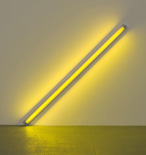We drove out to LACMA last weekend to see The Modern West: American Landscapes, 1890-1950, and Re-SITE-ing the West: Contemporary Photographs from the Permanent Collection.
I love exhibits like this . . . I’ve lived in California my whole life and I feel like these Western landscapes are part of my DNA.
While we were there, we also took in the Dan Flavin retrospective. Flavin’s work consists of standard fluorescent tubes arranged in patterns not beyond the imagination of the average six-year-old.
I tried viewing them up close, far away, from the side . . . I couldn’t make heads or tails of any of it.
LACMA helpfully provided a detailed theory of Flavin’s work in the form of a fold-out brochure with a lot of small print, but I didn’t read it. Isn’t art supposed to provide some sort of pleasure and/or illumination — pardon the pun — on its own merits?
I was reminded of Tom Wolfe’s epiphany in The Painted Word, that the distinction between, say, a Jackson Pollock painting and the splatterings of a kindergartener is that the kindergartener’s work lacks a persuasive critical theory:
All these years, in short, I had assumed that in art, if nowhere else, seeing is believing. Well–how very shortsighted! Now, at last, on April 28, 1974, I could see. I had gotten it backward all along. Not “seeing is believing,” you ninny, but “believing is seeing,” for Modern Art has become completely literary: the paintings and other works only exist to illustrate the text.


